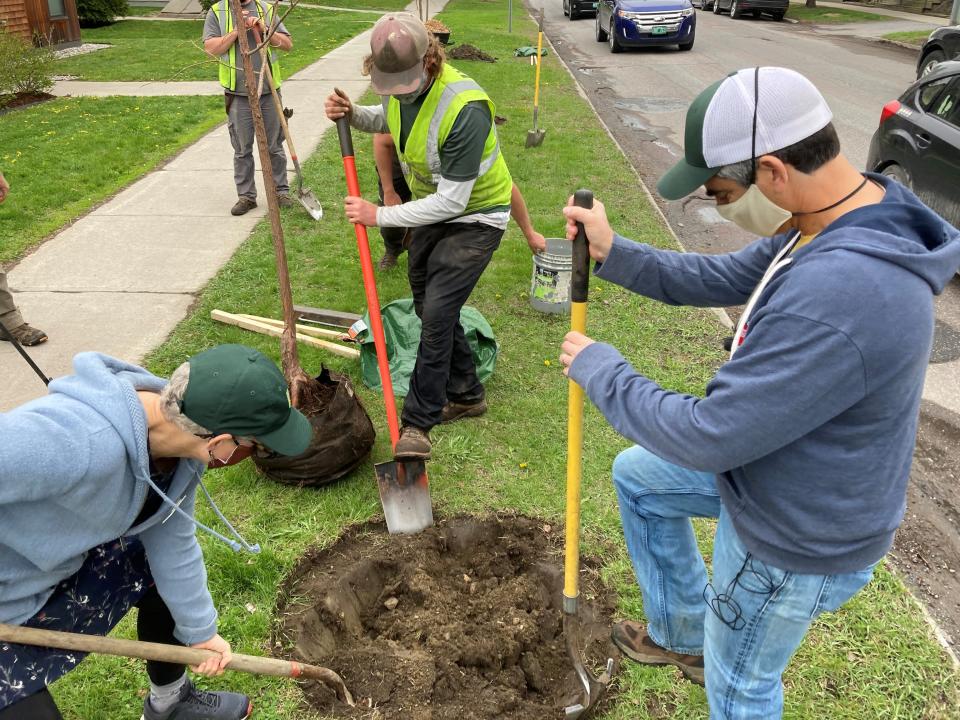Burlington's tree canopy can help cool the city, reduce carbon and even save money
The stifling heat around Burlington and Vermont has been uncharacteristic of Vermont this past week. Air conditioning and fans are the go-to cooling methods for many, but one thing can help cool the city and save money: the urban tree canopy.
As part of their Climate Action Plan, Burlington is working to increase the city's urban tree canopy by planting 588 trees a year, as stated by the Climate Action Plan. Increasing the tree canopy is more than just adding green to an urban area, and in fact impacts everything from carbon emissions to health to saving money.
More:Burlington's first heat wave of the season may last a while
What is a tree canopy?
Elise Schadler is the program manager for the Vermont Urban and Community Forestry program. When Vermont heats up, urban areas heat up even more than rural places. This effect is known as a heat island effect. Because the concentration of concrete and buildings which trap heat, urban areas are significantly hotter than the more rural areas nearby, according to Schadler.
More:Rest of Vermont might be cool but study shows Burlington is heating up
A mature tree can save anyone 20% on heating and cooling costs of a home, Schadler said. This is because the tree provides shade as well blocks the wind.
"Strategically planting on certain sides of your property can provide those benefits over time, if the trees are healthy and they're providing that shade and that wind blockage," Schadler said.

Trees also reduce pollution and carbon emissions. From 2017 to 2020, the Vermont Department of Health reported that trees planted absorbed 5,688 pounds of air pollutants and sequestered/avoided 1,184,601 pounds of Carbon Dioxide.
The state of tree canopies around VT
Although Burlington has been increasing the tree canopy through its Climate Action Plan, the city needs more trees in certain areas of the city. The Old North End is in need of trees the most, said Schadler.
One problem with planting in this area of Burlington is the widening of old roads leaves little green space between the road and sidewalk for trees to thrive. This is where residents can step in, by planting trees of their own- something that the Community Canopy Program looks to accomplish.
More:Rest of Vermont might be cool but study shows Burlington is heating up
The Community Canopy Program is run by the Vermont Urban and Community Forestry Program in partnership with the Arbor Day Foundation. Each year, the program works with selected urban areas around Vermont to provide a free tree to residents who register, according to Schadler.
"If you're a resident you're interested in a free tree you go on log to it's website to reserve your tree and when you do that, it allows you to kind of play around with like where on your property could you plant this tree that would provide the most benefit in terms of shading and energy reduction," Schadler said.
This year, the urban areas selected for the program are Barre, Burlington, Lyndon, and Windsor Vermont, as stated by the Community Canopy Program's website. Registration for the program opens in August, according to Schadler.
The program looks to provide those who could benefit the most from the trees, such as residents who don't have air conditioning or access to services in the case of a heat-related emergency, Schadler said.
Burlington's efforts to increase the tree canopy in the city have been implemented and are ongoing, as stated by the city's Climate Action Plan. To learn more about the Urban Tree Canopy in Burlington, contact the city's arborist VJ Comai at the Department of Parks, Recreation & Waterfront.
Kate O'Farrell is a reporter for the Burlington Free Press. You can contact her at KOFarrell@freepressmedia.com.
This article originally appeared on Burlington Free Press: Burlington's tree canopy cools the city, reduces carbon, and saves money

